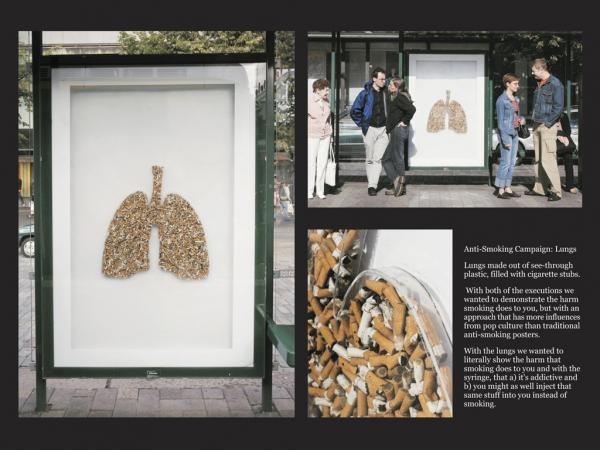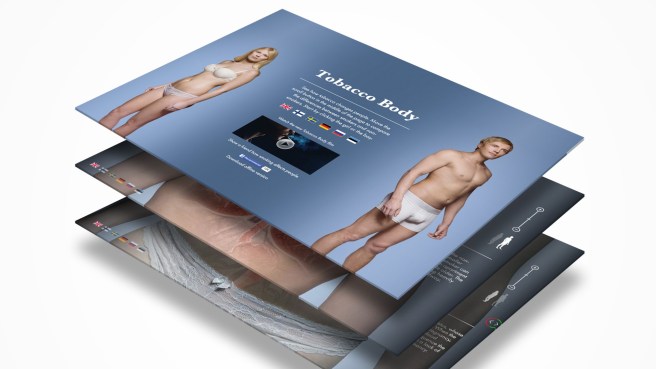
Tobacco addiction is one of the world’s most common health issue. According to Botvin and Eng in 1980, anti-smoking campaigns have always succeeded with young children. This level of effectiveness is most likely due to educational programs that inform them on the consequences and negative impacts of smoking. (Alvaro et al 2009) Another reason why it is effective is because the concept of fear is being implemented into the campaigns itself. “The heightened sense of fear of a particular subject will eventually lead to behaviour change“ (Thompson et al 2009) The direct implementation of fear in anti smoking campaigns has produced reliable results that its use are popularised by other groups attempting to prevent children from smoking in the future. However, is this method really effective to young adults?
The Cancer Society of Finland (CSF) is a charitable organisation and the main private contributor of cancer research in Finland. CSF also engages in movements promoting health towards adults interested in reducing their risk of cancer and health in younger generation, especially in tobacco consumption (Cancer Society of Finland 2016). Thus, their anti-smoking campaigns are often visually appaling
The Voice of Addiction (source: designleak.com, 2017)

Lungs/ Ashtray (source: coloribus.com, 2017)
White, T et al (2003) believes that fear is not enough to drive change in young adults. Infact, they believe that for fear to flourish, there needs to be a method or solution that allows young adults to avoid the negative consequences. This form of fear-themed campaigns can be seen through one of The Cancer Society of Finland campaigns named ‘Tobacco Body’



Tobacco body (source: VK | Design & Concept, 2017)
Tobacco Body is an interactive app designed by CSF alongside designer ‘Havas Worldwide – Helsinki’ in 2010. The app is a simple and creatively designed interactive tool that illustrates the contrast between the impacts of smoking towards a smoker and a healthy body. It is a highly versatile product that can be used as an effective educational tool for teachers educating young adults. The app successfully instilled fear on young adults as a way to persuade them to not smoke.
Tobacco Body’s interactive simple swiping feature reveals a healthy smoke-free body and a damaged smoker body which convey a sense of contrast between the two which encourage people to quit smoking. Moreover, the app has been designed with appealing flares and interactive elements complemented with easy navigation and clean template reinforces the success and sense of engagement towards the viewer. Thus, Tobacco Body is an example of an effective fear-themed campaigns as it provides the viewer information towards the health problem that raises due to smoking.
Smoking is still prevalent issue that needs to be constantly addressed. It is crucial to educate the future generation as they are responsible for their own lives and others around them.
Reference:
Alvaro, E. M., Burgoon, M., Grandpre, J., Hall, J. H., Miller, C. H. 2009,’ Adolescent Reactance and Anti-Smoking Campaigns: A Theoretical Approach’, Health Communication, vol.15 , no.3 , pp.349.
Cancer Society of Finland. 2016, Cancer Foundation,Finland, viewed on 13 December 2017, <https://www.cancersociety.fi/>.
Cancer Society of Finland. 2010, Tobacco Body, Finland, viewed on 13 December 2017, <http://tobaccobody.fi/>.
Coloribus. 2017, “Lungs / Ashtray” by Bob Helsinki for Cancer Society Of Finland, viewed on 13 December 2017, <https://www.coloribus.com/adsarchive/outdoor/cancer-society-of-finland-lungs-ashtray-14291855/>.
Designleak. 2017, The Voice of Addiction, Finland, viewed on 13 December 2017, <http://www.designleak.com/work/cancer-society-of-finland-the-voice-of-addiction/>
Thompson, L. E., Barnett, J. R., Pearce J. R. 2009, ‘Scared straight? Fear-appeal anti-smoking campaigns, risks, self-efficacy and addiction’ ,Health, Risk & Society, vol. 11 , no. 2 , pp. 182.
VK | Design & Concept. 2017, Tobacco Body, viewed on 13 December 2017, <http://villekovanen.com/portfolio/tobacco-body>.
White, T., Tan, N., Wakefield, M., Hill, D. 2003, ‘Do adult focused anti-smoking campaigns have an impact on adolescents? The case of the Australian National Tobacco Campaign’, Tobacco Control, Vol. 12, no. 2, pp.24 .

Before reading your post, I did not even think about the possible existence of an application relating to tobacco. I think what is most appealing about this initiative are the graphics and how they present themselves as more educational than gruesome like most campaigns!
Wow I never knew that tobacco campaigns could take such an interesting medium in order to educate younger people. It’s an effective approach in taking advantage of what the younger generation are familiar with such as that app, rather than the usual tv or print ads.
The graphics throughout this post are great! Really engaging! I also appreciate the exposition of both sides of the issue. Not just focusing on the value and impact of one campaign method, but explaining the effectiveness of each.